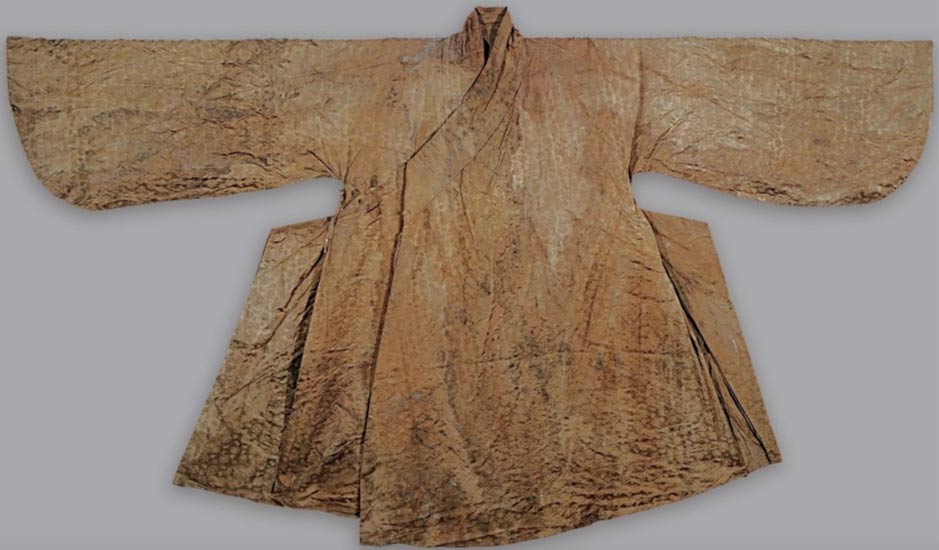Archaeologists unearth spectacular textiles in Ming Dynasty Tomb
Exactly how did Chinese people dress 500 years ago? What were their aspirations for the afterlife? Apart from artistic depictions and written descriptions, it is usually hard to tell exactly how individuals dressed hundreds of years ago because textiles rapidly deteriorate after burial. Common religious beliefs of a certain time in history are well-known, but individuals’ hopes of a blissful afterlife may not necessarily be expressed in their burial sites.
In 2008, archaeologists working in the Sensen Village section of Taizhou City on the East China Sea coast unearthed a couple’s grave that had finely preserved clothing of exceptional quality. The couple’s remains, even the bones, were mostly decomposed, but surprisingly, their clothing and some other things were intact, including fabrics with intricate designs such as a woman’s undershirt depicting a Qilin, a mythological hooved chimerical creature.

Patches from an undershirt in the wife’s coffin. The patches depict a Kylin or Qilin, a mythical creature with a dragon’s head, tail and a scaly body. Credit: Chinese Cultural Relics.
“The Kylin is shown amidst clouds, sea water and rocks. A banner found with the wife's coffin revealed that the woman buried here is ‘Lady Xu, Deceased Mother of the Wang family of the Ming Dynasty.’ The husband's banner was in poorer condition, although fine clothes were also found in his coffin,” LiveScience reports.
The image below, from Wikimedia Commons, more clearly shows a Qing Dynasty incense burner in the form of a Kylin or Qilin:

A mythological qilin (Wikimedia Commons)
The couple’s remains were in a tomb that contained two wooden coffins inside an outer coffin covered with a slurry of rice soup and lime. The researchers wrote that "the high level of preservation of the Ming Dynasty costumes has been attributed to the slurry layer that encloses the coffins and forms a seal.”
Two pillowcases among the husband’s grave goods express hope for a happy hereafter. The pillowcases were inscribed with the phrases “early fly to heaven” and “to be born in the next life in the Western World.” LiveScience suggests that the term “Western World” may refer to Sukhavati paradise or the Pure Land of Mahayana Buddhism. The researchers did not speculate what religion the couple adhered to.

One of the pillowcases found in the man’s grave. Credit: Chinese Cultural Relics.
Chinese archaeologists found skirts and shoes in the woman’s coffin. "The fabric is woven with flowers, insects and miscellaneous treasure patterns. The train of the skirt is woven in a full circle pattern of gold thread," Taizhou Municipal Museum researchers wrote in the Chinese Cultural Relics journal. "The shoe uppers are made of plain silk, and the toes are embroidered with patterns of flowers, ancient coins, square knots and chime stones. … “[H]eels are woven with floral and miscellaneous treasure patterns.”
The excavators also found a porcelain jar and a silver hairpin with gold cladding on the head of it in the wife’s coffin.
The man’s clothing was equally fine. The researchers said, “The fabric is woven with a lotus, peony, plum and chrysanthemum flowery pattern, interspersed with miscellaneous treasure patterns, such as coin, fire beads, horns, squares, banana leaves, ruyi scepter, silver bullion and chime stones.”
Archaeologists could not determine the exact date of the tomb. Based on the designs and artifacts they estimated it was laid around the time of the Ming Dynasty’s Jiajiang emperor, who ruled from 1521 to 1567 AD. The discovery has provided a fascinating insight into the garments worn by people of the Ming Dynasty, as well as their burial traditions and customs.
Featured image: The man’s gown found in the Ming Dynasty tomb. Credit: Chinese Cultural Relics journal.
By Mark Miller



















